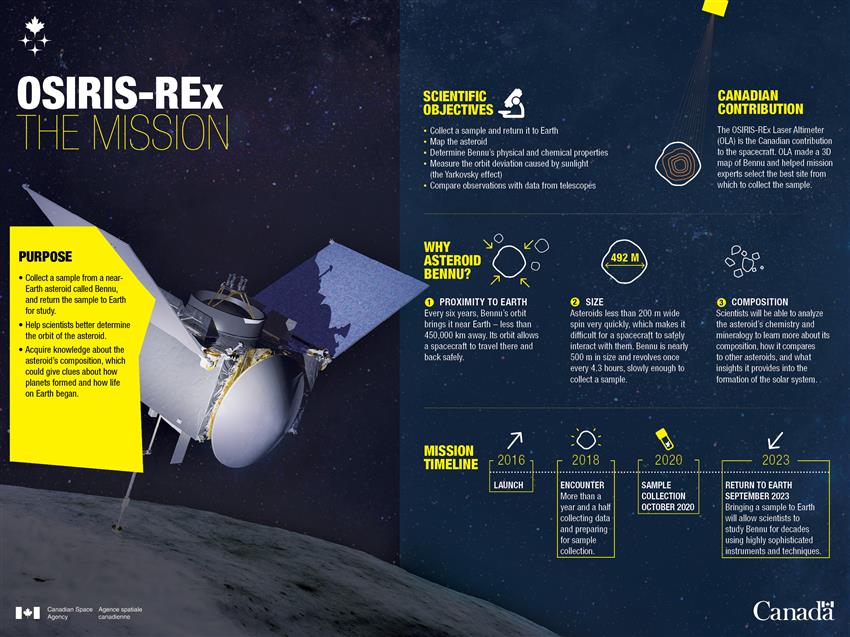About OSIRIS-REx
NASA's OSIRIS-REx mission marks Canada's first participation in an asteroid sample return. The OSIRIS-REx spacecraft travelled back to Earth from asteroid Bennu, where its Canadian lidar instrument created a 3D map to help scientists select a sample site. On , it released the capsule containing the asteroid sample, which parachuted down to Earth. Canada will receive a portion of the material.
Taking a closer look at carbon-rich Bennu may help answer questions about how our solar system formed and how life on Earth began.
- Launch:
- Sample collection:
- Arrival of sample on Earth:
- Arrival of sample in Canada:
- No earlier than

Text version - OSIRIS-REx: The Mission - Infographic
An overview of the OSIRIS-REx asteroid sample-return mission. (Credit: Canadian Space Agency)
Mission objectives
The OSIRIS-REx mission was designed to:
- map asteroid Bennu
- document the sample site
- measure the asteroid's orbit and factors which influence it
- compare observations at the asteroid to those made from Earth
- return a sample of Bennu's surface to Earth for analysis
This animation provides an overview of how the OSIRIS-REx spacecraft studied asteroid Bennu, collected a sample and returned it to Earth. Canada's OLA instrument can be seen firing an orange beam at 0:29. (Credit: NASA/Goddard Space Flight Center)
Canada's role
Canada has contributed technical and scientific expertise to the OSIRIS-REx mission. The Canadian Space Agency (CSA) provided OLA (OSIRIS-REx Laser Altimeter), a lidar system able to scan the asteroid from up to 7 km away, and supports:
- scientists and engineers on OLA's development and operations team
- scientists from Canadian institutions who are part of the broader OSIRIS-REx science team
How the mission worked
The seven-year mission consisted of several phases:
- launch, gravity assist with Earth, outbound cruise to Bennu
Following its launch in , the OSIRIS-REx spacecraft orbited the Sun for one year, then used Earth's gravity to change its orbit and help put it on course to asteroid Bennu.
The spacecraft began the asteroid approach phase in . The spacecraft then fired its rocket thrusters to adjust its speed and trajectory for a rendezvous with asteroid Bennu in December 2018.
- asteroid mapping
OLA spent approximately one year mapping Bennu's surface. Mission scientists then used that information to choose a location for the spacecraft to sample. Nightingale, near Bennu's north pole, was selected as the sample site.
- sample acquisition
OSIRIS-REx lowered itself down towards the surface, extended its robotic arm, and released a burst of nitrogen gas to stir up dust and gravel. The sampling module successfully collected more than 60 grams of surface material.
- return cruise and re-entry
OSIRIS-REx made its way back toward Earth. Its sample return capsule separated from the spacecraft and touched down in the Utah desert on .
- sample curation
The sample was sent to NASA's Johnson Space Center in Houston, where it will be curated and distributed to scientists and international collaborators. The Canadian portion of the sample is set to arrive at the John H. Chapman Space Centre (CSA headquarters) no earlier than .
This series of images was taken during the Touch-and-Go sample collection at the Nightingale site. Without landing, the robotic arm on board collected a sample that has been returned to Earth. (Credits: NASA/Goddard Space Flight Center, University of Arizona)
About the spacecraft
The OSIRIS-REx spacecraft was assembled by Lockheed Martin Space Systems. It is about the size of an SUV and includes five science instruments that scanned the asteroid in visible, infrared, and X-ray wavelengths.
When its solar panels are deployed, OSIRIS-REx can generate up to 3,000 watts of power. Although OLA contains approximately 4,000 mechanical parts and 3,000 electrical parts, the sophisticated instrument uses only 75W – similar to a lightbulb!
OSIRIS-REx's sample return capsule was equipped with a heat shield and parachutes to keep the asteroid sample intact as it entered Earth's atmosphere and to ensure a soft landing.
| Length | 6.2 m with solar panels deployed |
|---|---|
| Width | 2.4 m × 2.4 m |
| Height | 3.2 m |
| Length of sampling arm | 3.4 m |
| Dry mass (unfuelled) | 880 kg |
| Wet mass (fuelled) | 2,110 kg |
Mission partners
- NASA
- University of Arizona, including Principal Investigator Dr. Dante S. Lauretta
- Lockheed Martin Space Systems
International partners:
- CSA
- Japan Aerospace Exploration Agency
